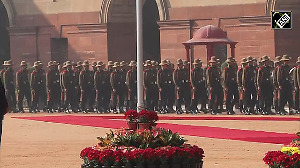The Bhopal tragedy was a defining moment for two of India's best known photographers. Raghu Rai and Pablo Bartholomew tell Tanushree Ghosh and Gargi Gupta about the pain of detachment.
If a picture is worth a thousand words, in the case of Bhopal, pictures are, perhaps, the only way to tell the entire story. Many photographers descended on Bhopal after December 3, 1984, but the work of Raghu Rai and Pablo Bartholomew define, for most people in India and the world, the unspeakable horrors of the 'worst industrial disaster ever'. Their photograph of a lifeless infant, nothing but his face visible against the backdrop of a mass grave, has become the definitive image of Bhopal, used on posters and protest banners even today.
Interestingly, both Rai and Bartholomew shot similar images, but it was the latter's, in colour, that won the World Press Photo Award in 1984. Rai's photographs of the time and later, showing the effects of the gas on those who lived, were compiled into a book, Exposure: Portrait of a Corporate Crime. An exhibition of these marked the 20th anniversary of the tragedy in 2004, and travelled over India, the US and Europe.
In 1984, Rai, then 42, was already well-known -- he'd been awarded the Padmashree for his Bangladesh photos in 1971 and in 1977 Henri Cartier-Bresson had nominated him to Magnum Photos, the premier photo agency. As the star photographer of news magazine India Today, Rai got the news within hours.
"It was a strange night. We couldn't sleep with the incessant phone calls and coordinating to catch the morning flight." Bartholomew, then 29, was working as a freelancer and in Sultanpur, on his way to Amethi to cover the election campaign, when he saw TV footage of bodies in handcarts. Both were on the same early morning Delhi-Bhopal flight that was ferrying several journalists to the disaster city.
Battle-hardened as they were -- Rai had covered cyclones besides the war and Bartholomew had a particularly eventful 1983-84 photographing the Nellie Massacre, the Khalsa movement in Punjab and the anti-Sikh riots in Delhi -- Bhopal was akin to an assault. What struck Rai was "the silence of death everywhere", while for Bartholomew the abiding memory is of the "smell of death", the acrid odour of hair burning.
The Hamidia hospital was their first port of call. There were dead bodies everywhere, and Rai recalls "we were going mad photographing...I felt very bad, we were like vultures looking for dead bodies". Rai decided to visit the children's ward. "[I thought] the condition of children would be more photogenic, more touching...When you have so much in front of you, any sensitive person will try to decide what is most important. Especially as a photographer and a journalist you choose."
For Bartholomew , sentiment or aesthetics didn't come in -- "you have to keep some distance, like a surgeon doing a heart operation".
The mass cremations and burials yielded many powerful images. The Hindus piled on large pyres," recalls Rai, "several bodies on one " and Muslims in "three-tier graves -- a body, then some mud, another body, more mud and then another body -- there was no time".
Rai stayed three days that first time, and Bartholomew a fortnight, photographing the scale of the devastation -- the dead animals bloated on the roadside, the man carrying his dead wife, the lawyers talking to victims...They went back again, every year for a while, Bartholomew unable to attend his brother's wedding because it coincided with the first anniversary of Bhopal. "It's as if," he says, "I was locked into the situation."
Both tried to find the identity of the dead child in the image, visiting the mass grave where they'd photographed him. They didn't succeed, but Rai came back with another searing image, of a man pointing to a shallow grave, where the mud had eroded, exposing a few bones -- the remains of his child.
Given their long and intense association with Bhopal, both are bitter not just about the recent judgement, but far more at the government's neglect of the victims. "They were treated badly in government hospitals...private doctors would exploit them, drugging them with all sorts of crap. Given the sordid situation, you question the country and what it stands for," says Bartholomew.
"We are a nation of dead, dying, fatigued minds," concludes Rai.







